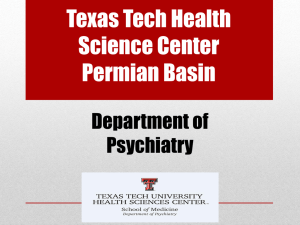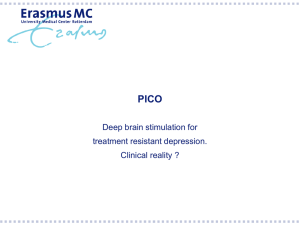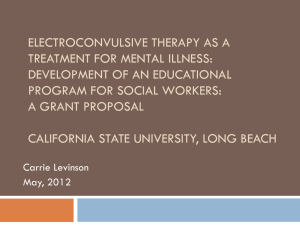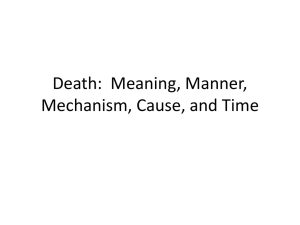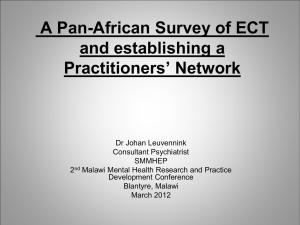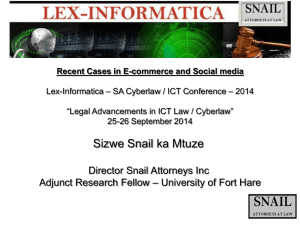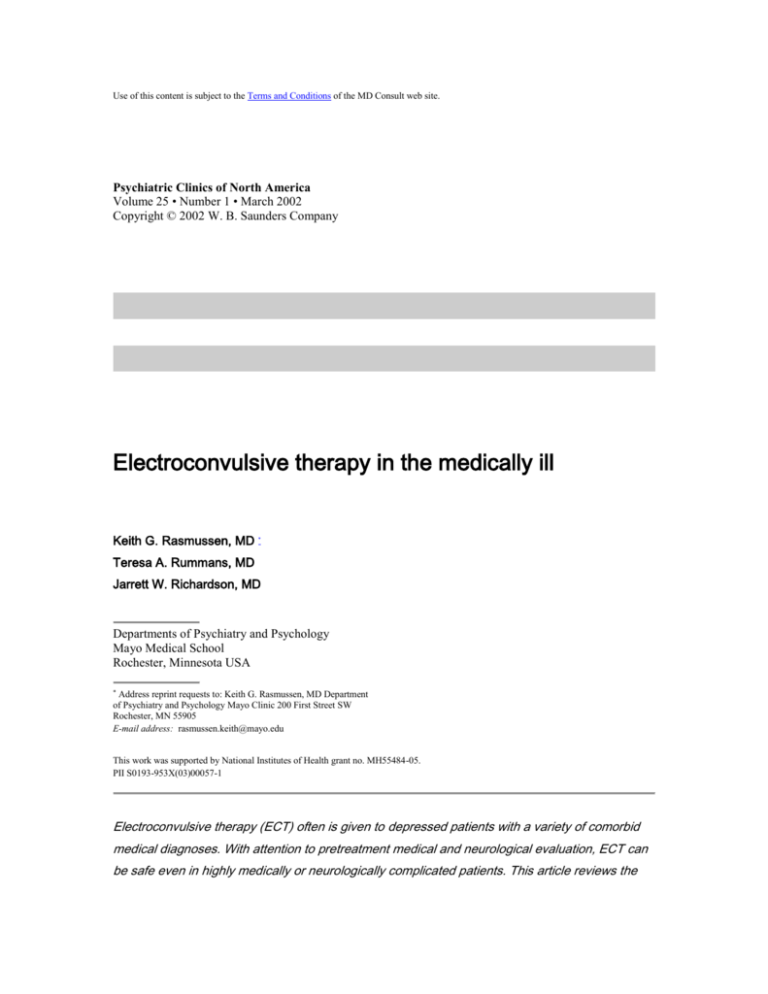
Use of this content is subject to the Terms and Conditions of the MD Consult web site.
Psychiatric Clinics of North America
Volume 25 • Number 1 • March 2002
Copyright © 2002 W. B. Saunders Company
Electroconvulsive therapy in the medically ill
Keith G. Rasmussen, MD
*
Teresa A. Rummans, MD
Jarrett W. Richardson, MD
Departments of Psychiatry and Psychology
Mayo Medical School
Rochester, Minnesota USA
*
Address reprint requests to: Keith G. Rasmussen, MD Department
of Psychiatry and Psychology Mayo Clinic 200 First Street SW
Rochester, MN 55905
E-mail address: rasmussen.keith@mayo.edu
This work was supported by National Institutes of Health grant no. MH55484-05.
PII S0193-953X(03)00057-1
Electroconvulsive therapy (ECT) often is given to depressed patients with a variety of comorbid
medical diagnoses. With attention to pretreatment medical and neurological evaluation, ECT can
be safe even in highly medically or neurologically complicated patients. This article reviews the
most commonly encountered medical and neurological illnesses in ECT patients and provides
suggestions for safe and effective use of ECT in such populations.
Three questions face the practitioner who is treating a patient with combined
medical and psychiatric illness for whom electroconvulsive therapy (ECT) is
being considered:
1. Is ECT effective in such patients?
2. Does ECT cause deterioration of the underlying medical condition or significant
side effects?
3. Is modification of ECT technique indicated to lessen the risk of adverse
outcomes?
To answer these questions definitively, prospective trials are needed in which the
severity of both the medical and the psychiatric illness are blindly rated in a
systematic manner before, during, and after treatment. Such trials are generally
lacking. Furthermore, in relying on case reports, one must consider that these
publications tend to be biased either in favor of excellent results or unexpectedly
poor outcomes; however, a large body of case reports and case series published
over several decades do inform the ECT clinician about a reasonable approach
to patients with a wide array of medical disorders. This section focuses on
medical conditions in which ECT has a direct physiologic effect and therefore
places the patient at risk for complications. These include cardiovascular,
neurologic, respiratory, and other disorders. In addition, the reader is strongly
encouraged to apply the principles contained in the APA Committee on ECT
report,[4] which has excellent sections on ECT in medically ill patients.
CARDIOVASCULAR DISEASES
Cardiac complications represent the most common source of significant morbidity
and mortality during ECT. Even so, deaths are extremely rare, and the majority of
cardiac patients can be given ECT with a low risk of complications.[2] There are
several fundamental points in providing safe ECT to such patients. The first is
accurate pre-ECT identification, through history, physical examination, and
screening laboratory tests, of those patients with cardiovascular disease. The
next step is pre-ECT cardiology consultation. The purpose of this is to determine
the severity of cardiac disease and may include functional or structural cardiac
imaging studies. The cardiology consultant can also recommend any modification
of the patient's current treatment regimen to provide further stabilization of the
cardiac condition (e.g., an increase in diuretic dosage in a patient with congestive
heart failure that is not optimally controlled). Finally, the medical consultant can
recommend strategies that may reduce cardiac risk during the ECT treatments,
such as the administration of β-blockers to lessen the ECT-induced decrease in
cardiac rate-pressure product. A third important strategy for safe administration
of ECT to cardiac patients is careful vigilance throughout the ECT course, both at
the times of treatment and in the intertreatment period, for any treatmentemergent complications so that prompt intervention can prevent deterioration of a
minor complication into a major one.
An elegant demonstration of the importance of these points is provided by two
reports from the Payne Whitney Clinic. Gerring and Shields[27] reported on a
series of 17 cardiac patients given ECT in 1975–1976. None of the patients had
pre-ECT medical consultations, electrolyte studies, or digitalis levels, even
though 13 of the patients were on this medication. Most patients did not get
continuous ECG monitoring during their treatments, nor were pretreatment
antihypertensive medications given. There were four life-threatening cardiac
complications and one death in this series. In contrast, Rice et al[75] reported on
their experience at the same institution treating 26 cardiac patients with ECT in
1990–1991. All of the technical disadvantages described earlier for the earlier
cohort had been reversed, so that routine pre-ECT laboratory and ECG studies
were performed, most patients had pre-ECT medical consultations, and ECT
technique followed modern standards, including continuous ECG monitoring and
the availability of cardiac medications at the time of treatment. No major cardiac
complications occurred in this cohort of patients. The following sections consider
the aspects of ECT technique in patients with specific types of cardiovascular
disorders.
Coronary Artery Disease
Cardiac complications during ECT are more common in those with coronary
artery disease (CAD) than with other cardiac conditions.[102] ECT induces
increases in pulse and blood pressure that result in a 200% to 300% increase in
myocardial oxygen consumption during and for a few minutes after the seizure [24]
; however, ECT can be safely administered to the majority of patients with CAD.
For patients with known CAD, pre-ECT cardiology consultation is recommended
to assess the stability of the patient's cardiac status and to assist with riskreduction strategies.[4] [5] The most important of such strategies is optimal
stabilization of cardiac status before treatment.[2] Pretreatment cardiac imaging is
commonly requested to assess the stability of the patient's myocardial capacity
during stress. Any cardiac medications the patient is taking, with the exception of
diuretics or lidocaine-type agents, should be given with a small sip of water the
mornings of treatment. A further strategy is the intravenous administration of βblockers immediately pretreatment to dampen the increase in myocardial oxygen
consumption.[8] If pretreatment β-blockade is used, then an anticholinergic agent,
such as glycopyrrolate or atropine, should also be given to minimize the risk of
vagally mediated prolonged asystole or bradycardia, which sometimes occur
early in the seizure or if no seizure is elicited by the electrical stimulus. [43]
Depression commonly accompanies the postmyocardial infarction period—
hence, the question of how long to wait until ECT is safe. Consideration should
be given to the severity of the patient's depression and cardiac stability. A patient
a few weeks out of a mild myocardial infarction with stable myocardial function
may be safer to treat than a patient many months or years out of myocardial
infarction with a very low ejection fraction or with exercise-induced ischemic
changes on cardiac imaging. Close communication between psychiatrist and
cardiologist is essential in these circumstances.
Dysrhythmias, Pacemakers, and Implantable Defibrillators
Patients with asymptomatic, uncomplicated cardiac conduction delays, such as
first degree heart block or bundle branch block, can be safely treated with ECT
without special precautions. Patients with atrial fibrillation also usually can be
treated safely[59] ; however, pretreatment cardiologic consultation can ensure
optimal stabilization and treatment of the dysrhythmia. In particular, ventricular
rate should be normalized. Occasionally, conversion to normal sinus rhythm
occurs during ECT, so pretreatment anticoagulation would be considered
optimal.[59] Patients with any type of malignant ventricular arrhythmia are at higher
risk for hemodynamic instability during ECT, so pretreatment cardiology
consultation is mandatory for risk assessment and risk-reduction strategies.
Lidocaine in antiarrhythmic doses has potent anticonvulsant properties, so it
should not be given before an ECT treatment unless truly necessary and no
alternative antiarrhythmic is available.
Patients with pacemakers usually do not need any special adjustment or
attention aside from ensuring that monitoring and other equipment are well
grounded.[2] Consultation with a cardiologist is indicated, and some older types of
pacemakers may need to be turned from demand mode to fixed mode before
treatment.[2] The use of transesophageal atrial pacing during ECT for patients at
significant risk for asystole has been described.[89] Patients with implantable
cardiodefibrillators usually can be safely treated with ECT, but pretreatment
consultation with a cardiac electrophysiologist is recommended.[4] [61]
Hypertension
Despite the transient, peri-ictal increase in blood pressure, ECT does not result in
sustained increases in blood pressure and in fact may result in a decrease in
blood pressure.[88] Common sense dictates that optimum blood pressure control
be attained in hypertensive patients pre-ECT. Antihypertensive medications
(except for diuretics, which could result in a full bladder that may rupture during
the seizure) should be given with a small sip of water in the mornings of
treatments. If there are significant risks to the patient for even brief periods of
hypertension (e.g., vascular aneurysms, cardiac aneurysm, severe left ventricular
or valvular compromise), premedication with antihypertensive agents is indicated,
selecting the drug that is most appropriate to the patient's clinical situation. Shortacting drugs (e.g., esmolol) administered at the time of anesthesia induction may
be preferable to avoid delayed hypotension that can occur with longer-acting
drugs (e.g., labetolol). Although β-blockade shortens seizure length during
ECT,[92] no direct evidence shows that this interferes with therapeutic efficacy.
Vascular Malformations and Anticoagulation
ECT has been safely administered in the presence of known cardiac[14] and aortic
aneurysms,[12] although a case of cardiac rupture during ECT has been
reported.[3] Pretreatment consultation with a vascular surgeon in cases of known
aneurysms or other vascular malformations (e.g., arteriovenous fistula) is
important in assessing the risk of rupture during ECT. Risk-reduction strategies
may include pretreatment with antihypertensive agents to reduce shear force
against the aneurysm.
For patients who are on anticoagulation for deep venous thrombosis, valvular
heart disease, atrial fibrillation, or another indication, it is prudent and safe to
continue it during ECT with close attention to maintaining the proper PT or PTT. [4]
Congestive Heart Failure and Valvular Heart Disease
As ECT causes a temporary but sharp increase in cardiac rate-pressure product,
patients with congestive heart failure are at risk for decompensation during a
course of ECT[72] ; however, successful administration of ECT to patients with
stable low cardiac output has been described.[86] ECT has been successfully
administered to patients with stable valvular heart disease.[32] [68] [72] As with the
other cardiac conditions discussed, the most important aspect of management in
such cases is careful pre-ECT cardiologic evaluation and risk assessment. In
particular, patients with congestive heart failure should have their medical
management optimized, with very careful ongoing assessment during the course
of ECT looking for signs of congestive decompensation.
NEUROLOGIC DISORDERS
A large body of case reports and case series published over several decades do
inform the ECT clinician about a reasonable approach to patients with a wide
array of neurologic disorders. This section considers such patients grouped by
type of neurologic illness. A thorough consideration of all published papers is
beyond the scope of this article, but the interested reader is referred to various
reviews published over the years [2] [18] [36] [81] [84] [103] .
Dementia
A vexing problem regarding the literature on ECT in demented patients is the
lack of standardized criteria for the establishment of a dementia syndrome
independent of depression-related cognitive dysfunction.[87] In fact, in routine
clinical circumstances, it is often difficult to determine whether the patient with
coexisting severe depression and cognitive dysfunction has a separate
dementing illness or depression-related cognitive dysfunction.[87] A further
problem with this literature is the lack of long-term cognitive follow-up in most
reports. Nevertheless, the extant literature does provide guidance on safe,
effective ECT in the depressed, demented patient.
Numerous case reports indicate that ECT can be efficacious in depressed and
demented patients for the depressive symptoms without causing undue or longlasting increases in memory disturbance.[67] Several case series provide more
substantial information. In a prospective study, Reynolds et al[74] systematically
followed depression ratings in a group of three demented depressives. Two of
these patients had an excellent antidepressant response to ECT without
cognitive worsening, whereas one had no antidepressant response and a sharp
reduction in mini-mental state exam (MMSE) score. Gaspar and Samarasinghe [26]
reported data on three patients with a diagnosis of primary dementia and
depression. Similarly, two showed a good antidepressant response, and one did
not. None of the patients were believed to have sustained a long-lasting (i.e.,
more than a few days) worsening of their baseline cognitive status, although no
systematic cognitive evaluations were done.
In a larger series, Nelson and Rosenberg[55] reported their experience treating 21
depressed and demented patients with ECT. Global antidepressant efficacy
ratings based on chart review were similar to those of a depressed but
nondemented ECT cohort. Post-ECT confusion was believed to be greater in the
depressed and demented group. No efficacy or cognitive follow-up data were
presented.
In the largest series to date of depressed and demented patients given ECT, Rao
and Lyketsos[67] described 31 patients, 16 diagnosed with vascular dementia, 4
with Alzheimer's dementia, and 11 with dementia of uncertain cause. Half the
patients were believed to suffer delirium (criteria not specified) with ECT. Two
thirds were believed to have a “good response” in terms of depression. MMSE
score actually increased an average of 1.62 points by treatment end. This
indicates the beneficial effect of ECT on attention and concentration after
clearing of the acute post-treatment confusion, even in demented patients. Of
note, one patient had tardive seizures in the recovery room after ECT. No
efficacy or cognitive data were presented separately for the different demented
groups.
To summarize, several dozen depressed ECT patients believed to have a
separate dementing illness have been described in the literature. Approximately
two thirds obtained noticeable antidepressant benefit, with approximately half
showing greater than usual confusional states. Sorely needed is a trial with
systematic cognitive evaluations in patients diagnosed with dementia by
standardized criteria, and subclassified by dementia type, compared with
nondemented ECT controls and with depressed and demented patients treated
with medications. Finally, in an effort to spare excess memory disturbance,
consideration should be given to treating depressed and demented patients with
right unilateral or bifrontal electrode placement and twice-weekly treatment
frequency.
Parkinson's Disease
A variety of case reports, small series, and one sham-ECT-controlled trial
document that ECT is highly effective for depression in Parkinson's disease and
may improve motor function as well[52] [69] ; however, delirium is common during
ECT,[22] as is treatment-emergent dyskinesia,[15] but post-treatment cognitive
function may be improved.[63] The duration of ECT-related antiparkinsonian
effects has been variable, but long-term follow-up data have been presented. For
example, Fall et al[19] systematically followed up 16 nondemented, nondepressed
patients with advanced Parkinson's disease before, immediately after, and for up
to 1.5 years after courses of mostly unilateral ECT. Fifteen subjects experienced
some improvement in the motor symptoms of PD, which was dramatic in some
cases. Half of the patients had sustained improvement for 3 to 18 months after
ECT, without maintenance ECT. Approximately one third developed severe
confusional states during ECT, the duration of which was a few days to 2 weeks.
Interestingly, 4 of these 5 patients went on to have long-lasting (i.e., at least
several months) motor improvement. Baseline increases in cerebrospinal fluid
(CSF)-to-serum albumin ratios, which were thought to reflect violation of the
blood-CSF barrier, accurately predicted the 5 subjects who developed interictal
delirium. None of the 11 subjects who did not develop interictal delirium had preECT increases in this ratio, indicating that violation of the blood-CSF barrier
before ECT predisposes to ECT-induced confusion.
In another series, Pridmore et al[65] treated seven advanced, nondepressed PD
patients with only four unilateral ECT treatments. Immediate post-ECT and 2week post-ECT ratings in all spheres of motor function indicated improvements.
Four patients developed severe, although temporary, confusion. One patient
developed a dyskinesia responding to lowering of the levodopa dose. In a followup report on these and several other such patients given index (but not
maintenance) ECT, three of nine initial ECT responders had improvements
lasting 2 to 10 weeks, whereas the other six responders had improvements
lasting 10 to 35 months.[64]
Attempts have been made to prolong the acute ECT-induced improvement in
motor symptoms of Parkinson's disease using maintenance ECT, in which
treatments are given every few weeks for variable lengths of time.[1] [20] [34] [83] [98] [101]
In these reports, a total of 13 patients with Parkinson's disease given
maintenance ECT are described. Several of the patients had had several
courses of index ECT with good, although relatively short-lived, motoric
improvement. In each case, maintenance ECT seemed to extend this period of
improvement, in some cases for up to 1 year. The frequency of such treatments
was highly variable, depending on the length of each patient's improvement, and
was balanced against cognitive impairment.
Several summary points can be made regarding the use of ECT in Parkinson's
disease patients:
It is highly effective for the severe depression so often seen in such patients.
In a substantial proportion of patients, a variety of extrapyramidal signs (EPS)
phenomena also may improve, often faster than the depression.
The duration of this antiparkinsonian benefit may be from a few days to years.
Maintenance ECT may extend the period of improvement in patients who can
tolerate it from a cognitive standpoint.
Treatment emergent dyskinesias and delirium are relatively common[15] [22] and
may be helped by careful reduction of dopaminergic doses.
Twice-weekly treatment frequency and right unilateral or bifrontal electrode
placement should be considered as methods to reduce memory impairment.
Neuroleptic-Induced Movement Disorders
Variable results have been reported with the use of ECT in patients with tardive
dyskinesia. For example, Yassa et al[100] found ECT helpful in reducing dyskinetic
movements in only one of nine such patients treated. Furthermore, Holcomb et
al[35] reported increased signs of tardive dyskinesia in a parkinsonian patient who
had good resolution of his parkinsonism with ECT. DeQuardo et al[10] even found
temporary spontaneous dyskinesias after ECT in a patient with Wilson's disease.
These results, combined with the known increase in levodopa-related
dyskinesias occurring commonly in patients with Parkinson's disease treated with
ECT,[15] indicate that ECT is unlikely to help dyskinetic movements in patients with
tardive dyskinesia and may even aggravate them. Interestingly, several cases of
improvement in tardive dystonia with ECT have been reported,[39] [44] [62] which is
not surprising given the similarity of this syndrome to parkinsonian
extrapyramidal signs, although one negative outcome has been reported.[30]
Neuroleptic malignant syndrome, one form of malignant catatonia,[60] often is
treated, after withdrawal of the neuroleptic, by administering dopamine agonists,
such as bromocriptine, and muscle relaxants, such as dantrolene or lorazepam.
ECT may represent a lifesaving option for patients who do not respond to these
measures.[56] [60] It may be the most effective treatment for neuroleptic malignant
syndrome, particularly when it occurs in a patient who was already catatonic.
Cerebrovascular Disease
Several isolated case reports[11] [96] of safe use of ECT in poststroke patients have
been published. Murray et al[53] and Currier et al,[9] describing experience at
Massachusetts General Hospital from 1969 to 1991 giving ECT to poststroke
patients, indicated that, of 34 such patients, 32 improved significantly with ECT.
Neither location of stroke, whether right-left or cortical-subcortical, nor time since
stroke (< l month to 12 years) was associated with clinical response. Five of six
patients showed improvement in their preexisting cognitive impairment with ECT
without neurologic worsening.
Martin et al[47] compared 14 poststroke ECT patients with 14 nonstroke ECT
patients and found a similar incidence of 4 of 14 in each group developing
interictal delirium. Interestingly, all 4 of the poststroke patients developing such
delirium had caudate strokes, buttressing the investigators' contention that basal
ganglia lesions predispose to ECT-related delirium. The poststroke ECT patients
had a good clinical response without neurologic worsening. Of note, the more
ECT treatments given after the delirium became apparent, the longer the delirium
lasted.
In addition to patients with a history of cerebrovascular accident (CVA), those
with known intracerebral aneurysms or vascular malformations would be
expected to have a high risk with ECT. At least two cases of patients safely
administered ECT after cerebral aneurysm repair have been reported,[21] [38] and
numerous cases of patients with known aneurysms that have not been surgically
corrected pre-ECT have been reported; in none of those has a bleed occurred. *
To the authors' knowledge, however, two cases of ECT-associated intracerebral
hemorrhages have been reported,[76] [97] both in patients without known pre-ECT
cerebrovascular disease. Most investigators reporting on ECT in patients with
known aneurysms used antihypertensive treatments to dampen the ECT-related
increase in blood pressure. Drop et al[17] consider intracerebral aneurysms at high
risk for rupture during ECT and recommend that appropriate antihypertensive
measures (e.g., β-blockade and sodium nitroprusside) and monitoring should be
undertaken during ECT in such patients.
To summarize the literature on ECT in patients with histories of stroke or
intracerebral aneurysm, numerous reports of safe ECT administration exist to
provide some confidence to the clinician; however, caution must be exercised,
and measures to control excessive blood pressure increases should be
considered.[17]
*
References [6] [16] [25] [37] [42] [54] [79] [93] .
Epilepsy
Giving ECT to epileptics is cause for concern; however, ECT potently increases
the seizure threshold during the course of treatments, and seizure lengths
progressively shorten, indicating that ECT has an anticonvulsant action. [78] Early
ECT clinicians knew about this effect and put it to use in treating epileptics with
intractable seizure disorders. For example, Taylor[91] reported on 19 epileptics
given ECT at a state hospital. One patient had no change in spontaneous seizure
frequency, one had a modest reduction, and 17 of 19 had a complete resolution
of such seizures while they were being treated with weekly ECT sessions.
Caplan,[7] in a similar population and using the same ECT method (i.e., thriceweekly ECT for a few weeks, followed by weekly maintenance treatments), also
found a reduction in the patients' spontaneous seizure frequency. Both
investigators found good psychopathologic improvement in psychosis, mood
disorders, and aggression. In Caplan's report,[7] when ECT was stopped,
spontaneous seizure frequency returned within 1 month to the pre-ECT levels,
indicating that the anticonvulsant action of ECT is temporary. Wolff[99] and, more
recently, Sackeim et al,[78] Griesemer et al,[28] Regenold et al,[73] Schnur et al,[82]
and Viparelli and Viparelli[94] have all described cases of patients with well-defined
epilepsy using modern diagnostic criteria who had highly refractory seizures in
whom substantial, although usually temporary, reductions in seizure frequency
were accomplished with ECT. In addition, occasional reports document that
status epilepticus can occur, fortunately rarely, after ECT, even in
nonepileptics.[29] [31] [66]
In the modern era, with highly sophisticated and extensive antiepileptic
treatments available, it would be extremely rare that an epileptic patient would be
given ECT for the purpose of reducing seizure frequency. More commonly, such
patients are given ECT for a mood, psychotic, or behavioral dyscontrol disorder.
Surprisingly, no large series of such patients describing outcome, both
therapeutic and cognitive, vis-a-ag-vis nonepileptic ECT patients exists. Such a
series would be a welcome addition to the ECT literature. At present, it can be
confidently stated that epilepsy itself does not present a contraindication to ECT,
and no evidence shows that spontaneous seizure frequency increases with ECT.
It would be prudent to maintain antiepileptic medication at therapeutic levels
during ECT to avoid withdrawal-associated status epilepticus.[33] If seizure
induction becomes impossible during the course of treatment because of the
anticonvulsant action of ECT, however, then careful, temporary downward
adjustment of the patient's anticonvulsant medication may be warranted, in
consultation with a neurologist, taking into account the nature and severity of the
patient's seizure disorder.
Intracranial Tumors
The original report of Shapiro and Goldberg[84] describing neurologic deterioration
after ECT in six patients subsequently found to have brain tumors led to the
belief that brain tumors constituted an absolute contraindication to ECT. This
viewpoint was supported in the review by Maltbie et al,[46] in which 35 patients
who had brain tumors found after ECT were described. In that series, the rates of
neurologic morbidity and mortality were quite high. Mattingly et al,[49] however,
reviewed 10 cases in which presence of the tumor was known in advance of
ECT. None of the patients had focal neurologic findings, increased intracranial
pressure (ICP), or papilledema before treatment. Neurologic deterioration was
not noted with ECT, and none of the patients died within 1 month after treatment.
In 8 cases, the tumors were meningiomas, and in 2 cases, they were metastatic
breast cancers. The investigators concluded that, in the absence of complicating
factors, such as increased ICP or focal neurologic findings, ECT may be safe if
the psychopathology warrants this treatment. Several other cases of successful
and neurologically uncomplicated administration of ECT to patients with
meningiomas have been described.[40] [41] [50] [85] Recently, the first case of an ECT
patient with increased ICP associated with a brain tumor, known in advance, was
reported.[57] The investigators used dexamethasone, furosemide, and β-blockade
before treatment to decrease both brain edema and the increase in ICP
associated with ECT. The patient enjoyed a good therapeutic response without
neurologic deterioration.
A prudent summary of the brain tumor and ECT literature is that presence of any
tumor probably presents an increased risk for neurologic complications caused
by ECT. In the absence of focal neurologic findings, brain edema, mass effect, or
papilledema, the risks probably are relatively small. In the presence of such
findings, however, the increased risk is probably quite high, and ECT should be
considered only in the context of profoundly urgent psychopathology. In any case
of known intracranial tumor in which ECT is being considered, consultation with a
neurosurgeon or neurologist to advise on risk assessment and risk-reduction
strategies (e.g., dexamethasone and furosemide) is indicated.
Miscellaneous
More than 12 cases of patients with multiple sclerosis receiving full courses of
ECT for psychopathologic states have been reported, with the suggestion that
gadolinium-enhancing lesions before ECT may presage a particularly high risk
for neurologic deterioration during treatment.[48] [80] Isolated case reports and small
series also describe safe and effective use of ECT in a diversity of other
neurologic conditions, such as cerebral palsy,[71] hydrocephalus with shunt,[45] and
spinocerebellar ataxia.[23]
PULMONARY DISORDERS
The two most common pulmonary disorders encountered in ECT practice are
asthma and chronic obstructive pulmonary disease. A paucity of data exist about
the relative efficacy and safety of ECT in patients with these conditions. Although
there seems to be no a priori reason to believe that ECT would be less effective
in such patients, some considerations regarding safety should be discussed. The
first is the risk for bronchospasm. Taylor[90] described a psychotically depressed,
asthmatic man who developed two episodes of short-lived bronchospasm during
his otherwise effective and uncomplicated course of ECT. The American
Psychiatric Association (APA) Committee on ECT[4] recommends that patients
with asthma and chronic obstructive pulmonary disease receive prescribed
bronchodilators before each treatment and that special attention be given to
oxygenation of such patients. A second safety concern is the risk for prolonged
seizures or status epilepticus in patients taking theophylline during ECT. Peters
et al[58] and Devanand et al[13] each described a patient who went into status
epilepticus with ECT while taking theophylline, and Abrams[2] has described three
more. Rasmussen and Zorumski[70] described a series of seven patients given
theophylline during ECT with nontoxic, therapeutic blood levels, none of whom
developed status epilepticus. It is recommended that theophylline be
discontinued before ECT. If that is medically contraindicated, then careful
attention should be given to maintaining the lowest therapeutic blood level,
concomitant caffeine augmentation should not be given, and ready access to
rapidly acting anticonvulsant medication (e.g., intravenous diazepam) should be
ensured.
MISCELLANEOUS MEDICAL DISORDERS
A variety of other medical considerations occur in ECT practice. In pregnancy,
the most common adverse events are premature labor, uterine contractions, and
vaginal bleeding.[4] [51] [95] During the third trimester, raising gastric pH before the
procedure with a nonparticulate antacid can minimize the risk for aspiration
pneumonitis. Adequately oxygenating but not hyperventilating the patient before,
during, and immediately after the procedure can minimize the risk for fetal
hypoxia.[4] [51] [95] The reader is especially referred to the APA Committee on ECT
report,[4] which has thorough recommendations regarding the use of ECT in
pregnant women.
Patients with diabetes mellitus should have their blood glucose levels monitored
closely during their ECT course. Glucose levels just before ECT may
demonstrate significant hypoglycemia in diabetics who are fasting and not taking
insulin. If this occurs, glucose can be given intravenously during the procedure.
Electrolyte abnormalities, such as hyperkalemia and hyponatremia, can lead to
severe complications, including cardiac dysrhythmias and seizures, respectively.
Significant reflux in those patients with hiatal hernias, gastroparesis, obesity, and
pregnancy may require measures to prevent aspiration pneumonia. Histamine-2
antagonists or antacids may decrease gastric acid, but for patients at severe risk
for aspiration, intubation may be necessary. Urinary retention from anticholinergic
agents given during ECT can predispose to urinary tract infections and even
bladder rupture if not monitored. With the use of skeletal muscle paralysis, the
risk for bone fractures is minimal with modern ECT; however, patients with
severe osteoporosis or recent fractures may need higher than usual muscle
relaxant dosing.[4] Testing the adequacy of paralysis with a peripheral nerve
stimulator is recommended in these circumstances. For the patient with unstable
cervical spine disease, pretreatment consultation with an orthopedic or
neurologic surgeon is recommended to assess the risk for injury, with the neck
manipulation needed to ventilate the patient during the treatment. With the
increase in intraocular pressure associated with ECT, precipitating glaucoma is
concerning; however, no published cases of this complication exist.
Administering antiglaucoma medications, except anticholinesterases, before ECT
is recommended for individuals with documented glaucoma requiring treatment. [4]
[77]
SUMMARY
ECT is often a necessary treatment for severe psychiatric disorders in patients
with medical or neurologic comorbidity. Although the available data consist
largely of cases and case series, ECT is effective in treating psychopathology
despite the comorbidity. With appropriate precautions and monitoring during and
after ECT, complications can be minimized.
References
Aarsland D, Larsen JP, Oyvind W, et al. Maintenance electroconvulsive therapy for Parkinson's disease.
Convulsive Therapy 1997;13:274-7.
2. Abrams R. Electroconvulsive therapy in the high-risk patient. New York: Oxford University Press; 1997.
p. 97-111.
3. Ali PB, Tidmarsh MD. Cardiac rupture during electroconvulsive therapy. Anaesthesia 1997;52:884-6.
Abstract
4. American Psychiatric Association, Committee on Electroconvulsive Therapy. ed 2 Washington, DC:
APA Press; 2001. The Practice of Electroconvulsive Therapy.
5. Applegate RJ. Diagnosis and management of ischemic heart disease in the patient scheduledto undergo
electroconvulsive therapy. Convulsive Therapy 1997;13:128-44.
6. Bader GM, Silk KR, Dequardo JR, et al. Electroconvulsive therapy and intracranial aneurysm.
Convulsive Therapy 1995;11:139-43.
7. Caplan G. Electrical convulsion therapy in the treatment of epilepsy. Journal of Mental Science
1946;92:784-93.
8. Castelli I, Steiner LA, Kaufman MA, et al. Comparative effects of esmolol and labetolol to attenuate
hyperdynamic statesafter electroconvulsive therapy. Anesth Analg 1995;80:557-61. Abstract
9. Currier MB, Murray GB, Welch CC. Electroconvulsive therapy for post-stroke depressed geriatric
patients. J Neuropsychiatry Clin Neurosci 1992;4:140-4. Abstract
10. Dequardo JR, Liberzon I, Tandon R. Recurrent post-ECT dyskinesias [letter]. Convulsive Therapy
1992;8:42-3.
11. Dequardo JR, Tandon R. ECT in post-stroke major depression. Convulsive Therapy 1988;4:221-4.
12. Devanand DP, Malitz S, Sackeim HA. ECT in a patient with aortic aneurysm. J Clin Psychiatry
1990;51:255-6. Abstract
13. Devanand DP, Sackeim HA, Decina P, et al. Status epilepticus following ECT in a patient taking
theophylline. J Clin Psychopharmacol 1988;8:153. Citation
1.
Dolinski SY, Zvara DA. Anesthetic considerations of cardiovascular risk during
electroconvulsivetherapy. [published erratum appears in Convulsive Therapy 13:284, 1997] Convulsive
Therapy 1997;13:157-64.
15. Douyon R, Serby M, Klutchko B, et al. ECT and Parkinson's disease revisited: A “naturalistic” study.
Am J Psychiatry 1989;146:1451-5. Abstract
16. Drop LJ, Bouckoms AJ, Welch CA. Arterial hypertension and multiple cerebral aneurysms in a patient
treatedwith electroconvulsive therapy. J Clin Psychiatry 1988;49:280-2. Abstract
17. Drop LJ, Viguera A, Welch CA. ECT in patients with intracranial aneurysm [letter]. Journal of ECT
2000;16:71-2.
18. Dubovsky SL. Using electroconvulsive therapy for patients with neurological disease. Hospital and
Community Psychiatry 1986;37:819-25.
19. Fall PA, Ekman R, Granerus AK, et al. ECT in Parkinson's disease: Changes in motor symptoms,
monoamine metabolitesand neuropeptides. J Neural Transm 1995;10:129-40.
20. Fall PA, Granerus AK. Maintenance ECT in Parkinson's disease. J Neural Transm 1999;106:737-41.
Abstract
21. Farah A, McCall WV, Amundson RH. ECT after cerebral aneurysm repair. Convulsive Therapy
1996;12:165-70.
22. Figiel GS. ECT and delirium in Parkinson's disease [letter]. Am J Psychiatry 1992;149:1759. Citation
23. Folkerts HE, Stadtland C, Reker T. ECT for organic catatonia due to hereditary cerebellar ataxia.
Journal of ECT 1998;14:53-5.
24. Fuenmayor AJ, el Fakih Y, Moreno J, et al. Effects of electroconvulsive therapy on cardiac function in
patients withoutheart disease. Cardiology 1997;88:254-7. Abstract
25. Gardner MW, Kellner CH. Safe use of ECT with an intracranial aneurysm [letter]. Journal of ECT
1998;14:290-2.
26. Gaspar D, Samarasinghe LA. ECT in psychogeriatric practice: A study of risk factors, indications
andoutcome. Compr Psychiatry 1982;23:170-5. Citation
27. Gerring JP, Shields HM. The identification and management of patients with a high risk for
cardiacarrhythmias during modified ECT. J Clin Psychiatry 1982;43:140-3. Abstract
28. Griesemer DA, Kellner CH, Beale MD, et al. Electroconvulsive therapy for treatment of intractable
seizures: Initialfindings in two children. Neurology 1997;49:1389-92. Full Text
29. Grogan R, Wagner DR, Sullivan T, et al. Generalized nonconvulsive status epilepticus after
electroconvulsive therapy. Convulsive Therapy 1995;11:51-6.
30. Hanin B, Lerner Y, Srour N. An unusual effect of ECT on drug-induced parkinsonism and tardive
dystonia. Convulsive Therapy 1995;11:271-4.
31. Hansen-Grant S, Tandon R, Maixner D, et al. Subclinical status epilepticus following ECT. Convulsive
Therapy 1995;11:139-43.
32. Hardman JB, Morse RM. Early electroconvulsive treatment of a patient who had artificial aortic
andmitral valves. Am J Psychiatry 1972;128:895-7. Citation
33. Hauser WA. Status epilepticus: Frequency, etiology, and neurological sequelae. Adv Neurol 1983;34:314. Abstract
34. Hoflich G, Kasper S, Burghof KW, et al. Maintenance ECT for treatment of therapy-resistant paranoid
schizophrenia andParkinson's disease. Biol Psychiatry 1995;37:892-4. Citation
35. Holcomb HH, Sternberg DE, Heninger GR. Effects of electroconvulsive therapy on mood,
parkinsonism, and tardivedyskinesia in a depressed patient: ECT and dopamine systems. Biol Psychiatry
1983;18:865-73. Abstract
36. Hsiao JK, Messenheimer JA, Evans DL. ECT and neurological disorders. Convulsive Therapy
1987;3:121-36.
37. Hunt SA, Kaplan E. ECT in the presence of a cerebral aneurysm [letter]. Journal of ECT 1998;14:123-4.
14.
Husum B, Vester-Andersen T, Buchmann G, et al. Electroconvulsive therapy and intracranial aneurysm:
Prevention of bloodpressure elevation in a normotensive patient by hydralazine and propranolol.
38.
Anaesthesia 1983;38:1205-7. Abstract
39. Kaplan Z, Benjamin J, Zohar J. Remission of tardive dystonia with ECT. Convulsive Therapy
1991;7:280-3.
40. Kellner CH, Burns CM, Bernstein HJ, et al. Safe administration of ECT in a patient with a calcified
frontal mass[letter]. J Neuropsychiatry Clin Neurosci 1991;3:353-4. Citation
41. Kellner CH, Rames L. Dexamethasone pretreatment for ECT in a patient with meningioma. Clin
Gerontol 1990;10:67-72.
42. Kolano JE, Chibber A, Calalang CC. Use of esmolol to control bleeding and heart rate during
electroconvulsivetherapy in a patient with an intracranial aneurysm. J Clin Anesth 1997;9:493-5. Abstract
43. Kramer BA, Allen RE, Friedman B. Atropine and glycopyrrolate as ECT preanesthesia. J Clin
Psychiatry 1986;47:199-200. Abstract
44. Kwentus JA, Schulz SC, Hart RP. Tardive dystonia, catatonia, and electroconvulsive therapy. J Nerv
Ment Dis 1984;172:171-3. Abstract
45. Levy SD, Levy SB. Electroconvulsive therapy in two former neurosurgical patients: Skullprosthesis and
ventricular shunt. Convulsive Therapy 1987;3:46-8.
46. Maltbie AA, Wingfield MS, Volow MR, et al. Electroconvulsive therapy in the presence of brain tumor:
Case reports and anevaluation of risk. J Nerv Ment Dis 1980;168:400-5. Abstract
47. Martin M, Figiel GS, Mattingly G, et al. ECT-induced interictal delirium in patients with a history of
CVA. J Geriatr Psychiatry Neurol 1992;5:149-55. Abstract
48. Mattingly G, Baker K, Zorumski CF, et al. Multiple sclerosis and ECT: Possible value of gadoliniumenhanced magneticresonance scans for identifying high-risk patients. J Neuropsychiatry Clin Neurosci
1992;4:145-51. Abstract
49. Mattingly G, Figiel GS, Jarvis MR, et al. Prospective uses of ECT in the presence of intracranial tumors
[letter]. J Neuropsychiatry Clin Neurosci 1991;3:459-63. Citation
50. McKinney PA, Beale MD, Kellner CH. Electroconvulsive therapy in a patient with a cerebellar
meningioma. Journal of ECT 1998;14:49-52.
51. Miller L. Use of electroconvulsive therapy during pregnancy. Hospital and Community Psychiatry
1994;45:444-50.
52. Moellentine C, Rummans TA, Ahlskog JE, et al. ECT and Parkinson's disease. J Neuropsychiatry Clin
Neurosci 1998;10:187-93. Abstract
53. Murray GB, Shea V, Conn DK. Electroconvulsive therapy for poststroke depression. J Clin Psychiatry
1986;47:258-60. Abstract
54. Najjar F, Guttmacher LB. ECT in the presence of intracranial aneurysm [letter]. Journal of ECT
1998;14:266-71.
55. Nelson JP, Rosenberg DR. ECT treatment of demented elderly patients with major depression:
Aretrospective study of efficacy and safety. Convulsive Therapy 1991;7:157-65.
56. Nisijima K, Ishiguro T. Electroconvulsive therapy for the treatment of neuroleptic malignant
syndromewith psychotic symptoms: A report of 5 cases. Journal of ECT 1999;15:158-63.
57. Patkar AA, Hill KP, Weinstein SP, et al. ECT in the presence of brain tumor and increased intracranial
pressure:Evaluation and reduction of risk. Journal of ECT 2000;16:189-97.
58. Peters S, Wochos D, Peterson G. Status epilepticus as a complication of concurrent electroconvulsive
andtheophylline therapy. Mayo Clin Proc 1984;59:568-79. Abstract
59. Petrides G, Fink M. Atrial fibrillation, anticoagulation, and electroconvulsive therapy. Convulsive
Therapy 1996;12:91-8.
60. Philbrick KL, Rummans TA. Malignant catatonia. J Neuropsychiatry Clin Neurosci 1994;6:1-13.
Abstract
61. Pinski SL, Trohman RG. Implantable cardioverter-defibrillators: Implications for
thenonelectrophysiologist. Ann Intern Med 1995;122:770-7. Abstract
62. Postalache TT, Londono JH, Halem RG, et al. Electroconvulsive therapy in tardive dystonia. Convulsive
Therapy 1995;11:275-9.
63. Pridmore S, Lowrie A, Holmes G, et al. ECT in Parkinson's disease: Neuropsychological response
[letter]. Convulsive Therapy 1997;12:257-65.
64. Pridmore S, Pollard C. Electroconvulsive therapy in Parkinson's Disease: 30 month follow up [letter]. J
Neurol Neurosurg Psychiatry 1996;61:693. Citation
65. Pridmore S, Yeo PT, Pasha MI. Electroconvulsive therapy for the physical signs of Parkinson's
Diseasewithout depressive disorder [letter]. J Neurol Neurosurg Psychiatry 1995;58:641-2. Citation
66. Rao KMJ, Gangadhar BN, Janakiramiah N. Nonconvulsive status epilepticus after the ninth
electroconvulsive therapy. Convulsive Therapy 1993;9:128-34.
67. Rao V, Lyketsos CG. The benefits and risks of ECT for patients with primary dementia who alsosuffer
from depression. Int J Geriatr Psychiatry 2000;15:729-35. Abstract
68. Rasmussen KG. Electroconvulsive therapy in patients with aortic stenosis. Convulsive Therapy
1997;13:196-9.
69. Rasmussen K, Abrams R. Treatment of Parkinson's Disease with electroconvulsive therapy. Psychiatr
Clin North Am 1991;14:925-33. Abstract
70. Rasmussen KG, Zorumski CF. Electroconvulsive therapy in patients taking theophylline. J Clin
Psychiatry 1993;54:427-31. Abstract
71. Rasmussen KG, Zorumski CF, Jarvis MR. ECT in patients with cerebral palsy. Convulsive Therapy
1993;9:205-8.
72. Rayburn BK. Electroconvulsive therapy in patients with heart failure or valvular heartdisease.
Convulsive Therapy 1997;13:145-56.
73. Regenold WT, Weintraub D, Taller A. Electroconvulsive therapy for epilepsy and major depression. Am
J Geriatr Psychiatry 1998;1988:180-3. Abstract
74. Reynolds CF, Perel JM, Kupfer DJ, et al. Open-trial response to antidepressant treatment in elderly
patients withmixed depression and cognitive impairment. Psychiatry Res 1987;21:111-22. Abstract
75. Rice EH, Sombrotto LB, Markowitz JC, et al. Cardiovascular morbidity in high-risk patients during
ECT. Am J Psychiatry 1994;151:1637-41. Abstract
76. Rikher KV, Johnson R, Kamal M. Cortical blindness after electroconvulsive therapy. Journal of the
American Board of Family Practice 1997;10:141-3.
77. Saad D, Black J, Krahn L, et al. ECT post eye surgery: Two cases and a review of the literature. Journal
of ECT 2000;16:409-14.
78. Sackeim HA, Decina P, Prohovnik I, et al. Anticonvulsant and antidepressant properties of
electroconvulsive therapy: Aproposed mechanism of action. Biol Psychiatry 1983;18:1301-10. Abstract
79. Salaris S, Szuba MP, Traber K. ECT and intracranial vascular masses. Journal of ECT 2000;16:198-203.
Savitsky N, Karliner W. Electroshock therapy and multiple sclerosis. New York State Journal of
Medical Science 1951;51:788.
81. Savitsky N, Karliner W. Electroshock in the presence of organic disease of the central nervous system.
Journal of Hillside Hospital 1953;2:3-22.
82. Schnur DD, Mukherjee S, Silver J, et al. Electroconvulsive therapy in the treatment of episodic
aggressive dyscontrolin psychotic patients. Convulsive Therapy 1989;5:353-61.
83. Serby M, Moros D, Rowan J, et al. Maintenance ECT as adjunctive treatment to dopaminergic drugs in
Parkinson'sdisease [abstract]. Biol Psychiatry 1994;35:654.
84. Shapiro MF, Goldberg HH. Electroconvulsive therapy in patients with structural diseases of the
centralnervous system. Am J Med Sci 1957;233:186-95.
85. Starkstein SE, Migliorelli R. ECT in a patient with a frontal craniotomy and residual meningioma. J
Neuropsychiatry Clin Neurosci 1993;5:428-30. Abstract
86. Stern L, Hirschmann S, Grunhaus L. ECT in patients with major depressive disorder and low cardiac
output. Convulsive Therapy 1977;13:68-73.
87. Stoudemire A, Hill CD, Morris R, et al. Improvement in depression-related cognitive dysfunction
following ECT. J Neuropsychiatry Clin Neurosci 1995;7:31-4. Abstract
88. Swartz CM, Inglis AE. Blood pressure reduction with ECT response. J Clin Psychiatry 1990;51:414-6.
Abstract
80.
Szafranski JS, Oberoi MP, Chetty PK, et al. Use of transesophageal atrial pacing during
electroconvulsive therapy. Anesthesiology 1996;84:211-4. Citation
90. Taylor G. Electroshock therapy in the asthmatic patient. Canadian Psychiatric Association Journal
1968;13:187-8.
91. Taylor JH. Control of grand mal epilepsy with electro-shock. Diseases of the Nervous System
1946;7:284-5.
92. Van den Broek WW, Leentjens AF, Mulder PG, et al. Low-dose esmolol bolus reduces seizure duration
during electroconvulsivetherapy: A double-blind, placebo-controlled study. Br J Anaesth 1999;83:271-4.
Abstract
93. Viguera A, Rordorf G, Schouten R, et al. Intracranial haemodynamics during attenuated responses to
electroconvulsvietherapy in the presence of an intracerebral aneurysm. J Neurol Neurosurg Psychiatry
1998;64:802-5. Abstract
94. Viparelli U, Viparelli G. ECT and grand mal epilepsy [letter]. Convulsive Therapy 1992;8:39-42.
95. Walker R, Swartz C. Electroconvulsive therapy during high-risk pregnancy. Gen Hosp Psychiatry
1994;16:348-53. Abstract
96. Weintraub D, Lippmann S. Electroconvulsive therapy in the acute poststroke period. Journal of ECT
2000;16:415-8.
97. Weisberg LA, Elliott D, Mielke D. Intracerebral hemorrhage following electroconvulsive therapy
[letter]. Neurology 1991;41:1849. Citation
98. Wengel SP, Burke WJ, Pfeiffer RF, et al. Maintenance electroconvulsive therapy for intractable
Parkinson's disease. Am Geriatr Psychiatry 1998;6:263-9.
99. Wolff GE. Electro-convulsive treatment: A help for epileptics. American Practitioner and Digest of
Treatment 1956;7:1791-3.
100. Yassa R, Hoffman H, Carakis M. The effect of electroconvulsive therapy on tardive dyskinesia: A
prospectivestudy. Convulsive Therapy 1990;6:194-8.
101. Zervas IM, Fink M. ECT for refractory Parkinson's disease [letter]. Convulsive Therapy 1991;7:222-3.
89.
Zielinski RJ, Roose SP, Devanand DP, et al. Cardiovascular complications of ECT in depressed
patients with cardiacdisease. Am J Psychiatry 1993;150:904-9. Abstract
103. Zwil AS, Pelchat RJ. ECT in the treatment of patients with neurological and somatic disease. Int J
Psychiatry Med 1994;24:1-29. Abstract
102.
Copyright © 2005 Elsevier Inc. All rights reserved.
Bookmark URL: /das/journal/view/49416321-2/N/12227696?ja=417102&PAGE=1.html&ANCHOR=top&source=
www.mdconsult.com


